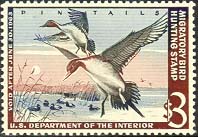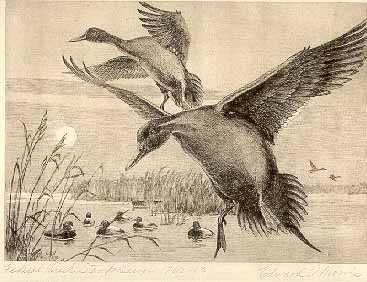

Back to RW29 Back to the Federal Index Home
A LITTLE HISTORY ON THE 29TH (1962-63) DUCK STAMP ARTIST


Although Edward A. Morris was born a Philadelphia boy and returned to that city for his formal art education after World War II, there was a time when he grew dissatisfied with his life there. A keen appreciation of the outdoors is a trait that is a prerequisite to all good wildlife artists and Mr. Morris found that it was increasingly difficult to stay in touch with nature while living in the city.
He labored at various outdoor activities but eventually decided that he needed to make a move. The natural place for him to go was the birthplace of several famous wildlife artists, Minneapolis, Minnesota. The city had long been a mecca for prominent wildlife artists and Mr. Morris hoped that he could meet with some success and satisfaction there. He was very satisfied with the locality and was especially fulfilled with his work in the north woods of the state.
Mr. Morris continued to free-lance for some time in this location. He also worked in advertising art and had a studio at the American Wildlife Art Galleries. His work has often appeared in the annual exhibition of the American Watercolor Society. Many of his paintings are also in numerous other eastern galleries and museums.
He finally decided to make his move west and settled in Montana. He says that it was "one of the better moves I made." He was intrigued with the old and the modern west with its infinite variety of contrasts.
There he found a rich source of material for his painting and sculptures. In his work, he developed his own realistic style in portraying the scenery, costumes, people, animals, and culture of this ever changing region.
He presently finds sculpture most interesting. Over the years his work has appeared in a wide variety of media. these include oil, watercolor, pen and ink, bronze, stone, lithography, and dry-point etching.
Despite his life of seclusion, he has continued to display his artwork locally. He had a show at a local museum in May 1983 that included newspaper articles and pictures from his earlier life. He has had shows in several Montana towns as well as in Oregon.
Mr. Morris is a member of Ducks Unlimited, the Association of Professional Artists, and a Minneapolis sportsmen's club, Fur, Fin and Feathers. He has always been an avid fisherman, and enjoys living in the heart of trout country.
In a letter to his good friend, Russ Fink, he wrote, "People work all year to vacation in this area, and now I live in the midst of it all year. I'm not so dumb."
-------------------------THE ART-------------------------
Pintails was a watercolor wash. The print is a dry-point etching aquatint
hand pulled on antique white English Text. The print is hand signed in pencil but
not numbered. Edward is the only artist to win two years in a row. The image
size of the print is 6 3/4" x 9 1/4".
-------------------------THE STAMP-------------------------
Pintails...Engraved by the Federal Bureau of Engraving from the original artwork.
Printed in grey-black, light purplish blue, and moderate reddish brown ink. The stamp sold
for three dollars. Postal records show 1,147,553 stamps sold. First day of
sale was July 1, 1962.
Most of the information contained above is from the book Federal Duck Stamp Story, Fifty Years of Excellence, by Laurence F. Jonson; Alexander & Co. It is used here with permission from the author. For more information on this book, please click here.